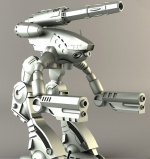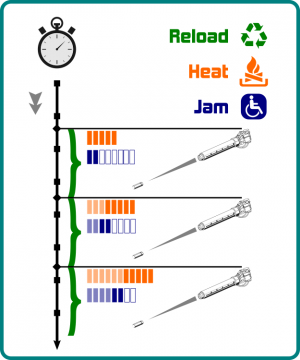Difference between revisions of "DPS"
Fire-hound (talk | contribs) (→Types of DPS) |
Fire-hound (talk | contribs) |
||
| Line 12: | Line 12: | ||
* splash damage - dealt by explosion and | * splash damage - dealt by explosion and | ||
* secondary splash damage - dealt by explosion (or fire?) as well | * secondary splash damage - dealt by explosion (or fire?) as well | ||
| + | |||
| + | === Total Damage === | ||
| + | Total damage is usually calculated by simply adding all damages up. The actual damage in game can be more than this, due to splash damage being accounted for hitting adjacent components of one or more assets in vicinity of the hit.<br> | ||
=== Damage Modifiers === | === Damage Modifiers === | ||
Assets in the game have each their own adjusted damage modifiers to compensate for optimal balance, skill and fun across the various types. | Assets in the game have each their own adjusted damage modifiers to compensate for optimal balance, skill and fun across the various types. | ||
* TODO | * TODO | ||
| + | |||
| + | === Average Total Damage === | ||
| + | Once we account for all modifier types, we can derive an average by adding them together and dividing them by their quantity. This is the simple linear average. Then we can apply them to the Total Damage to calculate the Average Total Damage as a single value for a given weapon. | ||
=== Damage per ton of Ammo === | === Damage per ton of Ammo === | ||
The maximally possible damage dealt for firing one ammo clip (usually a ton). Actual damage can only be lass or, at most, equal to this. | The maximally possible damage dealt for firing one ammo clip (usually a ton). Actual damage can only be lass or, at most, equal to this. | ||
| + | |||
== Types of DPS == | == Types of DPS == | ||
Revision as of 22:26, 8 May 2019
Contents
Introduction
DPS or Damage Per Second is a popular measure of a weapons worth, and besides Range and Alpha damage (damage per single shot) constitutes the most looked after characteristic of particular weapon in the sense of battle worthyness.
Delivering an actual DPS value for any weapon is easier said than done, because the rate of fire might be affected by various factors and circumstances that are subject to change them self during the time of battle.
This complexity is at moments bordering uncertainty while never really crossing the line. This mechanic alone is what makes Battletech games one of the finest entertainment delights for the truly devoted players.
Damage Types
Our game differentiates between few damage types:
- direct damage - dealt by collision or contact
- splash damage - dealt by explosion and
- secondary splash damage - dealt by explosion (or fire?) as well
Total Damage
Total damage is usually calculated by simply adding all damages up. The actual damage in game can be more than this, due to splash damage being accounted for hitting adjacent components of one or more assets in vicinity of the hit.
Damage Modifiers
Assets in the game have each their own adjusted damage modifiers to compensate for optimal balance, skill and fun across the various types.
- TODO
Average Total Damage
Once we account for all modifier types, we can derive an average by adding them together and dividing them by their quantity. This is the simple linear average. Then we can apply them to the Total Damage to calculate the Average Total Damage as a single value for a given weapon.
Damage per ton of Ammo
The maximally possible damage dealt for firing one ammo clip (usually a ton). Actual damage can only be lass or, at most, equal to this.
Types of DPS
In Battletech and Mechwarrior games we understand that there are some so called basic weapons, the loadouts of the lostech era.
Those are the standard Inner Sphere Lasers, Autocannons and SRM MRM and LRM missiles. Those have in common that they don't have jam constrains and usually are delivering more hurt than heat.
Calculating DPS for those weapons usually involves only the fire rate and damage per shot. Not terribly complex. Same applies for LB-X.
Enter Ultra Autocannons:
Everyone who ever fired an Ultra Autocannon knows the delight of it's almost double both rate of fire and damage output. Alas the delight that has to end every so often as the darn thing jams up and ceases to deliver the hurt. The number of shots fired, or, rather the time spend in non-stop firing until fully jammed we call the jam time or time to jam. Usually there is 4 to 6 salvos to be fired before this comes in act.
Looking at the image to the right those are the blue tokens - the empty ones are shots left before the jam, the pale ones are shots that still count as fired in close succession. As time lapses, the pale shots might deplete and allow for more shots to be fired yet. This however spoils the DPS - as we are trying to shoot as mush as possible and as soon as possible.
But wait there's more! Not only does the jam probability build up during firing in a quick succession, each shot also produces heat. That heat is transferred to the assets internals and has to be dissipated via the heatsinks present on the unit.
This mechanism is represented in orange on the image to the right. We see that each successive shot adds like 5 tokens, but on the next shot only 3 of them remain as pale tokens, while 2 are "gone missing". Those are dissipated via the heatskins by the time the next shot is fired.
Should the asset build up too much heat by carelessly firing too much weapons too many times in succession, adverse effects and conditions might rise to be and reduce the DPS further.
In effect that means that besides the Raw DPS, which lasts only so long, we have some other, normalized DPS, if we want to account for all the lams and heat buildups.
- TODO RAC, HAG, missiles
Raw DPS
Here we merely account for the maximal possible DPS for any to shots fired in closest succession. Simple as that.
Max DPS
Estimated DPS
Normalized DPS per clip of ammo
Also known as sustained DPS - or worst case DPS.

